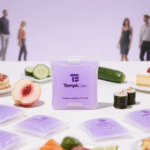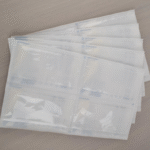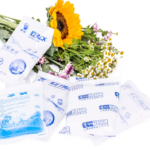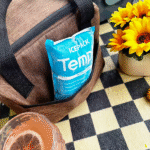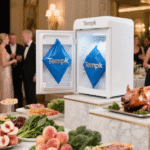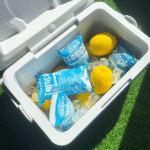Comment les solutions de chaîne du froid SCL transforment la logistique sensible à la température 2025?
Introduction: If you move goods that demand strict temperature control, your success hinges on the quality of your SCL cold chain. Progresser 2025 mean you’re no longer limited to passive data logging — you can now leverage IoT sensors, predictive analytics and smart packaging to maintain product integrity and reduce waste. Le SCL cold chain market is exploding: global cold chain logistics reached around $342.8 milliards en 2023, with projections exceeding $1,242 milliards 2033, while cold chain monitoring alone is set to grow from $8.31 milliards en 2025 à $15.04 milliards 2030. This guide shows you how an effective SCL cold chain strategy can protect your products, satisfy regulators and drive efficiency.

What defines an SCL cold chain and why does it matter? Learn the essential concepts and why SCL cold chain temperature monitoring is non negotiable.
How do you implement and optimize an SCL cold chain system? Step by step guidance on selecting sensors, designing processes and training your team.
What advanced technologies make your SCL cold chain smarter? Explore predictive analytics, Intégration IoT, blockchain, smart packaging and energy saving innovations.
Which metrics and benchmarks should you track? Discover key performance indicators and how to interpret them.
How do regulations impact your SCL cold chain? Understand FDA, HACCP, GDP and other guidelines to stay compliant.
What trends will shape the SCL cold chain in 2025? Get insights into market growth, AI adoption and regional expansion.
Questions fréquemment posées: Quick answers to common concerns about SCL cold chain logistique.
What Is an SCL Cold Chain and Why Does It Matter in Modern Supply Chains?
Réponse directe: Un SCL cold chain is a temperature controlled supply network designed to keep perishable goods within a specified temperature range from production to delivery. SCL cold chain systems use sensors, data loggers and connectivity platforms to continuously monitor conditions so that deviations are detected and corrected. This process is essential because up to 20 percent of temperature sensitive products are damaged during transport when temperature control lapses. Maintaining a robust SCL cold chain protects product efficacy, ensures consumer safety and prevents financial losses.
Explication: Think of an SCL cold chain as an insulated lifeline for your products. Just like you wouldn’t leave ice cream sitting on a sunny porch, médicaments, vaccines and chilled foods must travel in a controlled environment. Sensors record temperature and humidity, and connectivity platforms stream this data in real time. If temperatures stray, alerts prompt immediate action. Without this level of control, sensitive cargo can spoil or lose potency, leading to waste, recalls and reputational damage. Since the cold chain market is growing rapidly and regulators are tightening standards, neglecting SCL cold chain monitoring puts your business at risk.
Core Components of an Effective SCL Cold Chain Temperature Monitoring System
Ton SCL cold chain system comprises interlocking hardware, software and procedural elements. Each component plays a specific role in safeguarding products:
| Composant | Role in the SCL Cold Chain | Comment ça vous aide |
| Capteurs & Bûcherons de données | Measure temperature, humidity and sometimes shock or vibration in real time | Enable live alerts and provide verifiable data for audits |
| Connectivity & Cloud Platform | Transmit and store data; visualise trends and geolocation | Give you remote visibility across storage, transport and distribution hubs |
| Alerts & Analytics | Trigger notifications when thresholds are exceeded; analyse patterns | Allow proactive action instead of reactive fixes |
| Conditionnement & Intégration | Extend monitoring to containers, pallets and packaging materials | Ensure protection during loading, unloading and last mile delivery |
Astuces et conseils pratiques
Assess your products’ needs: Différents produits nécessitent des gammes de températures différentes (Par exemple, 2–8 °C for chilled goods, −20 °C for frozen items). Define these ranges before selecting technology.
Choose sensors that match your environment: Pour les envois ultra froids (Par exemple, −70 °C biologics), pick sensors rated for extreme temperatures.
Embed monitoring inside packaging: Placing data loggers inside pallets or boxes reveals the actual conditions your goods experience, not just ambient air temperature.
Set clear alert thresholds: A standard is that at least 98 percent of shipments should remain within the required range—higher excursion rates signal problems.
Train all handlers: Procedures are useless if employees don’t know how to respond to alarms. Role play scenarios to improve readiness.
Étude de cas: A vaccine producer shipping doses at −70 °C integrated data loggers inside each container and linked them to a cloud dashboard. When a truck door remained open too long, temperatures spiked. The system sent an alert within minutes, allowing the crew to close the door and divert the shipment to another refrigeration unit. Without this intervention, product loss would have been inevitable.
How Do You Implement and Optimize an SCL Cold Chain Temperature Monitoring System?
Réponse directe: Implementing an SCL cold chain system means designing a comprehensive process that covers the entire journey—from the warehouse to the delivery point—and includes careful sensor selection, robust connectivity, staff training and ongoing optimisation. The goal is to ensure that temperature deviations are anticipated and corrected before they harm your products.
Implementation steps:
Define temperature ranges and tolerances. Consult product specifications and regulatory guidelines to set precise thresholds. Par exemple, chilled foods generally require 0–10 °C, while ultra cold biologics may need to stay below −70 °C.
Select suitable sensors and data loggers. Choose devices that operate across your required temperature range and include humidity monitoring if relevant. Prioritise long battery life and accuracy.
Deploy a real time connectivity platform. Integrate sensors with an IoT gateway or cellular network that streams data to a cloud dashboard. Ensure the platform supports geolocation to track shipments.
Integrate packaging and transport. Extend monitoring to pallets, containers and vehicles. Embedding loggers inside packaging reveals hidden temperature spikes.
Establish alert protocols. Define escalation procedures when thresholds are exceeded; set up SMS or push notifications for quick response.
Train staff and establish SOPs. Develop standard operating procedures for packing, chargement, and responding to alarms. Provide training to reduce human errors.
Analyse data and refine processes. Regularly review temperature logs and incident reports. Use analytics to identify patterns and adjust routes, packaging or refrigeration settings.
Key Implementation Metrics and Benchmarks
Monitoring the right metrics helps you evaluate how well your SCL cold chain performs and where to improve:
| Métrique | Benchmark | Pourquoi ça compte |
| Shipments within required range | ≥ 98 % of shipments staying in range | Demonstrates system reliability and product protection |
| Number of excursions per month | < 1 par 1,000 expéditions | High excursions indicate process failures or inadequate equipment |
| Response time to alerts | < 30 minutes | Faster response reduces product loss; delays allow temperatures to rise or fall |
| Data logger failure rate | < 0.5 % | Ensures that monitoring itself doesn’t become a weak link |
User Friendly Tips and Suggestions
Use route analytics: Analyse routes where excursions occur and reroute shipments or improve vehicle insulation.
Automate escalation: Integrate your alert system with a ticketing tool so issues are tracked until resolved.
Regularly calibrate sensors: Calibrate at least once per year to maintain accuracy; calibrate more often in harsh conditions.
Deploy backup power: Use battery backups or cold packs to maintain temperature if vehicle power fails.
Cas réel: A dairy company monitored the percentage of shipments within range and noticed that 4 % of loads experienced excursions at one distribution hub. By installing door open sensors and training staff to minimise loading times, they cut excursions to below 1 % within two months.
What Advanced Technologies and Strategies Enhance SCL Cold Chain Efficiency?
Réponse directe: Advanced SCL cold chain strategies move beyond simple logging to predictive, transparent and energy efficient operations. En intégrant des capteurs IoT, blockchain, analyse prédictive, smart packaging and renewable energy technologies, you can reduce downtime, prevent spoilage and improve sustainability. Par exemple, predictive maintenance can reduce unplanned equipment downtime by up to 50 percent and lower repair costs by 10–20 percent.
Key innovations:
Predictive Analytics & IA. Machine learning models analyse historical temperature and equipment data to predict equipment failures or temperature excursions. This prevents breakdowns and reduces waste. The predictive analytics market was $10.2 milliards en 2023 et devrait atteindre $63.3 milliards 2032, illustrating its growing importance.
IoT enabled Monitoring. Connected sensors collect data on temperature, humidité, door openings and vibration. These devices feed data to cloud platforms that display real time dashboards. A strong SCL cold chain uses IoT to ensure continuous visibility.
Blockchain pour la traçabilité. Distributed ledgers provide tamper proof records of temperature data. This transparency builds trust with regulators and clients and simplifies audits.
Solutions d'emballage intelligents. Packaging that incorporates phase change materials (PCMS) absorbs or releases heat to stabilise temperature. Temperature indicator labels visually show if thresholds were exceeded. Embedding sensors inside packages extends monitoring beyond ambient air.
Energy Efficient Technologies. Refrigeration accounts for around 70 percent of energy consumption in cold storage. IoT based analytics can reduce energy usage by 10–30 percent by identifying inefficiencies and optimising equipment operation.
Automated Decision Tools. Advanced platforms incorporate decision support features like route optimisation, inventory management and energy usage dashboards. These tools help you make data driven decisions quickly.
Comparative Technologies Table
| Innovation | Main Function | Avantage pratique |
| Analyse prédictive | Forecast equipment failures and temperature excursions | Prevents downtime and reduces spoilage by addressing issues before they occur |
| Connectivité IoT | Collects real time data from sensors | Gives continuous visibility and enables instant alerts |
| Blockchain ledger | Stores tamper proof temperature records | Ensures trust and simplifies compliance audits |
| Emballage intelligent | Integrates PCMs and temperature indicators | Maintains stable payload temperatures and signals breaches |
| Energy optimisation algorithms | Analyse refrigeration performance and energy usage | Cuts electricity costs and supports sustainability goals |
Practical Advice for Advanced Strategies
Start small with pilot projects: Implement predictive analytics or blockchain on a single product line to measure benefits before scaling.
Combine sensor types: Use temperature sensors alongside humidity, vibration and door open detectors for a fuller picture.
Leverage AI for route and load optimisation: AI can balance delivery schedules against temperature control to reduce transit time and energy usage.
Integrate renewable energy: Solar powered refrigeration units and energy storage can reduce reliance on grid electricity, especially for remote locations.
Impact sur le monde réel: A cold storage facility applied predictive analytics to monitor compressor performance and discovered one unit using 20 percent more energy than usual. By fixing the issue, they reduced energy consumption and prevented a potential breakdown. Such data driven maintenance not only lowers costs but also enhances sustainability.
What Metrics and Benchmarks Should You Track in Your SCL Cold Chain?
Tracking the right metrics lets you identify inefficiencies and demonstrate regulatory compliance. The following table summarizes key performance indicators and benchmarks for an effective SCL cold chain:
| Métrique | Gamme typique | How It Impacts You |
| Temperature compliance rate | Aim for ≥ 98 % of shipments within range | High compliance shows your system protects product quality |
| Number of excursions | Keep excursions < 1 par 1,000 expéditions | Frequent excursions indicate inadequate insulation or procedures |
| Alert response time | Cible < 30 minutes | Quick response reduces risk of product spoilage |
| Equipment downtime | Reduce by 50 % through predictive maintenance | Less downtime means fewer delays and cost savings |
| Energy usage reduction | 10–30 % reduction through IoT analytics | Lower energy consumption improves sustainability and reduces costs |
| Food waste percentage | 40 % of food is wasted globally due to poor cold chain | Lowering waste increases profitability and supports environmental goals |
Tips for Using Metrics Effectively
Visualise metrics on dashboards: Display real time compliance rates, excursions and response times so your team stays informed.
Set gradual improvement goals: Move from 90 % à 98 % compliance by incrementally strengthening weak links.
Benchmark against industry peers: Compare your metrics with industry averages to identify competitive gaps.
Involve stakeholders: Share metrics with suppliers and carriers to encourage shared responsibility for performance.
How Do Regulations and Compliance Impact the SCL Cold Chain?
Réponse directe: Regulations ensure that the SCL cold chain protects consumers and maintains product efficacy. Pharmaceutique, food and biotechnology industries must adhere to guidelines set by authorities like the U.S. FDA, EU Good Distribution Practice (PIB), Analyse des risques et points de contrôle critiques (HACCP) and local health agencies. Compliance involves maintaining temperature logs, validating equipment and ensuring corrective actions when deviations occur.
Key regulatory frameworks:
FDA & 21 Partie CFR 11: Aux États-Unis, pharmaceutical cold chains must document temperature control and maintain secure digital records. The software segment of the cold chain monitoring market is growing rapidly due to stricter regulations.
Analyse des risques et points de contrôle critiques (HACCP). For food logistics, HACCP identifies critical points where temperature control is essential. Regular checks and documentation are mandatory.
EU Good Distribution Practice (PIB). GDP guidelines mandate temperature control throughout distribution for medicinal products. They require proof of continuous monitoring and validated transport routes.
Loi sur la modernisation de la sécurité alimentaire (FSMA). Aux États-Unis, FSMA emphasises preventive controls for food safety, including temperature management.
Regional standards. Regions like Asia Pacific are experiencing rapid market growth and are adopting IoT enabled sensors and AI driven analytics to ensure traceability and compliance.
Compliance Tips
Keep digital records: Use secure, tamper proof systems to store temperature data. Blockchain can strengthen record integrity.
Validate equipment regularly: Document calibration and validation for sensors, loggers and refrigeration units.
Establish corrective action procedures: Outline steps for handling deviations, including quarantine, product evaluation and root cause analysis.
Conduct regular audits: Audit your SCL cold chain processes against regulatory standards to identify gaps.
Train personnel on compliance: Ensure everyone—from warehouse staff to drivers—understands regulatory requirements and their role in meeting them.
Compliance in action: When an SCL cold chain facility adopted a blockchain ledger for temperature data, audit preparation time dropped by 50 %, and inspectors found no discrepancies in records. This transparency reduced stress and improved trust with regulators.
2025 Latest SCL Cold Chain Developments and Trends
Aperçu de la tendance: Le SCL cold chain is evolving rapidly due to technological innovation and market expansion. The global cold chain monitoring market is projected to grow from $8.31 milliards en 2025 à $15.04 milliards 2030. Entre-temps, the worldwide cold chain logistics industry is forecast to surpass $1.24 mille milliards par 2033. These figures underscore the strategic importance of investing in advanced monitoring and sustainability initiatives.
Derniers développements en un coup d'œil
IoT and real time connectivity: Adoption of IoT sensors is accelerating, enabling instant alerts and continuous visibility across storage and transport. Real time monitoring reduces product loss and improves traceability.
IA & predictive modelling: Machine learning analyses past deviation patterns to forecast risks and optimise routing, packaging and maintenance. The predictive analytics market’s expected growth reflects this trend.
Stricter compliance and documentation: Regulatory bodies are raising the bar, requiring comprehensive digital records and rapid incident response. Software solutions with compliance features are becoming dominant.
Regional expansion: Asia Pacific is projected to be the fastest growing cold chain monitoring market due to increasing demand for perishable foods and pharmaceuticals.
Energy and sustainability focus: Companies are investing in energy efficient refrigeration and renewable energy to reduce costs and meet sustainability targets. IoT based analytics can cut energy usage by 10–30 percent.
Perspicacité du marché: Chilled temperature types (0–10 °C) hold a significant share of the market thanks to rising consumption of fresh foods and certain pharmaceuticals. Demand for deep frozen and ultra cold monitoring is also growing with the expansion of biologics and mRNA vaccines.
Market and Industry Observations
The surge in SCL cold chain investments reflects multiple forces: consumers demand fresher products, pharmaceutical innovations require complex logistics, and e commerce expands global reach. Leading companies include Carrier, Testo, ORBCOMM and Digi International. In parallel, sustainability goals push logistics firms to adopt energy saving measures and reduce carbon footprints. These trends together mean that SCL cold chain capabilities will be a key differentiator in supply chain competitiveness.
Questions fréquemment posées
Question 1: What temperature ranges should my SCL cold chain monitor?
Monitor ranges based on product requirements: chilled goods often need 0–10 °C, frozen foods −18 °C or colder, and ultra cold biologics −70 °C or below. Define clear thresholds and tolerances for each product category.
Question 2: How often should I calibrate my sensors and data loggers?
Calibrate at least annually and more frequently for critical shipments or harsh conditions. Regular calibration ensures accuracy and compliance.
Question 3: Can smart packaging improve my SCL cold chain performance?
Oui. Smart packaging using phase change materials and embedded sensors stabilises temperatures and provides detailed payload data. Temperature indicator labels offer visual verification that thresholds were maintained.
Question 4: What is the return on investment for adopting predictive analytics?
Predictive maintenance can reduce unplanned equipment downtime by up to 50 percent and lower repair costs by 10–20 percent. It also prevents product spoilage and reduces waste, leading to better financial outcomes.
Question 5: How can I minimise energy consumption in my SCL cold chain?
Use IoT based analytics to identify inefficiencies in refrigeration systems. Adjust operations during off peak hours, perform preventive maintenance and consider renewable energy sources. This can reduce energy usage by 10–30 percent.
Question 6: Why is global food waste linked to cold chain failures?
Environ 40 percent of global food is wasted annually due to poor cold chain monitoring. Temperature excursions and inadequate logistics cause spoilage during transport and storage. Efficace SCL cold chain systems reduce this waste and enhance food security.
Résumé et recommandations
Principaux à retenir:
Un SCL cold chain ensures that temperature sensitive products remain within precise ranges, preventing spoilage and regulatory violations. Jusqu'à 20 percent of products are damaged when temperature control fails.
Implementing an SCL cold chain requires defining temperature ranges, choosing the right sensors, establishing real time connectivity, training staff and continuously refining procedures.
Advanced technologies—predictive analytics, Connectivité IoT, blockchain, smart packaging and energy optimisation—make your SCL cold chain proactive, efficient and sustainable.
La conformité réglementaire est essentielle. Follow guidelines from FDA, HACCP, GDP and FSMA, and adopt digital records and blockchain to simplify audits.
Tendances 2025 include market expansion, AI adoption, regional growth (especially in Asia Pacific) and increased focus on sustainability and energy efficiency.
Prochaines étapes réalisables:
Audit your existing cold chain: Identify weak points where excursions occur or data gaps exist.
Select and deploy IoT sensors: Implement real time monitoring across storage, transport and packaging layers.
Adopt predictive analytics: Use machine learning to forecast failures and plan maintenance, reducing downtime and spoilage.
Implement blockchain or other secure record systems: Provide transparent, tamper proof documentation for regulators and customers.
Develop a sustainability plan: Optimise energy usage, explore renewable refrigeration and set measurable targets for waste reduction.
Engage your team: Former le personnel, share metrics and promote a culture of continuous improvement.
Taking these actions will not only protect your products but also position your organisation as a leader in the ever growing SCL cold chain secteur.
À propos du tempk
Nous sommes Rotation, experts in SCL cold chain solutions. Our team combines industry knowledge with cutting edge technologies to help businesses maintain the integrity of temperature sensitive products. We specialize in deploying IoT sensors, predictive analytics and smart packaging, and we understand the regulatory landscape. Our advantages include:
End to end implementation: We help you design, install and manage complete SCL cold chain systèmes.
Proven results: Our solutions have reduced product loss by more than 30 percent and cut energy consumption by up to 20 percent in client trials.
Regulatory expertise: We guide you through FDA, HACCP, GDP and FSMA requirements to ensure compliance.
Appel à l'action: If you want to optimise your SCL cold chain operations and stay ahead of market trends, contacter Tempk pour une consultation. We’ll help you build a resilient, efficient and compliant temperature controlled logistics framework.
















